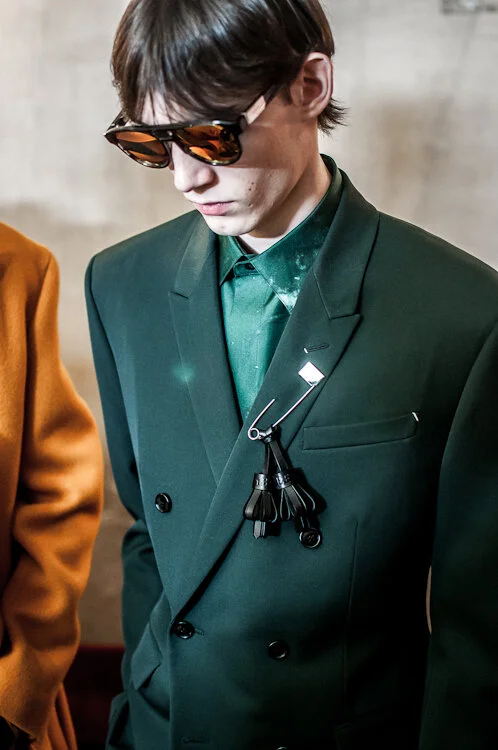TIMELESS MELODY
Kris Van Assche is bringing the past into the future at Berluti with a fresh, street-smart take on luxury.
BY LAURA BOLT
PHOTOGRAPHY BENOIT AUGUSTE
When you think about what it means to be timeless, it’s easy to imagine classic clothes that wouldn’t be out of place fifty years ago or in a shop window today. But what if timeless meant designing without time, incorporating a sense of history into the imaginary look of the future? This might just be the case with Kris Van Assche, who has redefined the Berluti look of late. Since joining the brand in 2018, Van Assche has transformed the Berluti man into his own vision of timeless masculinity, one that knows where he came from and where he is going. “My work has always been about building bridges between youth and their culture, and a more traditional, elegant, and luxurious world,” he said. “I truly believe I made young kids look differently at tailoring and luxury in general. At the same time, I have always worked on making luxury and tradition modern. It’s definitely a two-way bridge.”
After ten years as Creative Director of Dior Homme, the Belgian designer has immediately won praise for his fresh perspective on Berluti, a melange of luxury materials and edgy styling that he achieves with help from Italian stylist Mauricio Nardi. Van Assche took over from Haider Ackermann, who had imbued with Berluti with a sense of luxury and romanticism. Ackermann’s tenure at Berluti was marked by a sense of bohemian romanticism, the look of poets and renaissance men. Van Assche meanwhile, has struck a more minimalist tone, roughed up with the streetwear inspired aesthetic that has become such a powerful force in today’s menswear.
Van Assche has taken a “from the ground up” approach to his work at Berluti, a nod to the brands origins as a footwear company. Before his Berluti debut, he acknowledged that “If my previous work always started with a black suit, I can definitely say that here it starts with the shoes.” In fact, without a historical archive to pull from in terms of menswear, shoes have been the only throughline to the brand’s past that Van Assche has had to pull inspiration from. This has created an opportunity to play with ideas about how to translate a focus on strong manufacturing with clothes that have a wearable, and modern, edge.
Even though the only archival material was footwear, Van Assche still started his design journey by going back to the source. “We took a flight to the manifattura in Ferrara which is the factory where the shoes are made. And that was something that blew me away. It’s a new territory for me, kind of. The factory is really super-modern and super-sophisticated, but there is also this really traditional handcraft element that is key to the products they make. And so the contrast between the super-contemporary and a hand-crafted sensibility was a really nice starting point for me,” he explained. The resulting high patina and sharp lined shoes move boldly into the future, creating a strong building block that forms the foundations of his clothing.
In the mid 1980s, six upstart designers from Belgium turned the fashion world on its head with an avant garde sensibility that spoke to a sense of youthful rebellion. Dubbed the Antwerp Six, these young designers (Dries Van Noten, Ann Demeulemeester, Dirk Van Saene, Walter Van Beirendonck, Dirk Bikkembergs and Marina Yee) collectively put Belgium on the map as a fashion destination on par with London and New York. Thanks to their influence, for the last 30 years Belgian design has been synonymous with modern, cutting edge fashion. Van Assche is part of that lineage, bringing a disruptive edge to classic menswear.
Van Assche is part of a growing community of menswear designers who are bringing streetwear style to the runway. Like Dior’s Kim Jones and Louis Vuitton’s Virgil Abloh, Van Assche’s work has an undeniable sense of power and movement, pairing in your face sneakers with sleek suiting, and offsetting classic silhouettes with graphic prints. There is an appreciation for the past, but with a sense of adventure and the insouciance of youth. “This adventurous man will explore various lifestyles, it's a man that takes the best of all worlds. It's about freedom. It's about knowing the rules and messing them up a little, it’s about broken suits, leather pants and wool knits. The Berluti man is a rebellious free-spirited man, he does things his own way...Also, it's about a love for a new Berluti man, who is more interested in seduction than my previous men,” he said. That seduction seems to be rooted in the idea of translating an echo of the past into a flirtation with the future. It’s a way of redefining masculinity by merging hard and soft, minimalism and whimsy.
It’s no wonder that Van Assche has brought new fans to the brand, including rapper and style icon A$AP Rocky and Oscar winner Rami Malek, who debuted the first Van Assche for Berluti design on the red carpet last year. Both men embody the kind of forward thinking design Van Assche has become known for. The “Berluti man” contains multitudes, refusing to be pinned down. “Berluti is about freedom,” Van Assche expalins. “People often try to put menswear in boxes. And because luxury menswear is supposed to be timeless and therefore it tends to be neutral, as well. But I am convinced that at Berluti obviously while it is supposed to be a high end luxury it is also supposed to be really remarkable: look twice clothes.”
With sophisticated tailoring and luxury materials meeting edgy new wave sensibility, it’s fair to say that if Van Assche continues his exploration of fusing past and present, the Berluti of the future will be commanding attention for years to come.




